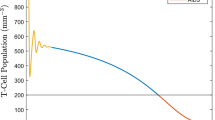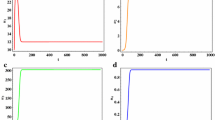Abstract
Mathematical models are developed for the chemotherapy of AIDS. The models are systems of differential equations describing the interaction of the HIV infected immune system with AZT chemotherapy. The models produce the three types of qualitative clinical behavior: anuninfected steady state, aninfected steady state (latency) and aprogression to AIDS state. The effect of treatment is to perturb the system from progression to AIDS back to latency. Simulation of treatment schedules is provided for the consideration of treatment regimes. The following issues of chemotherapy are addressed: (i) daily frequency of treatment, (ii) early versus late initiation of treatment and (iii) intermittent treatment with intervals of no treatment. The simulations suggest the following properties of AZT chemotherapy: (i) the daily period of treatment does not affect the outcome of the treatment, (ii) treatment should not begin until after the final decline of T cells begins (not until the T cell population falls below approximately 300 mm−3) and then, it should be administered immediately and (iii) a possible strategy for treatment which may cope with side effects and/or resistance, is to treat intermittently with chemotherapy followed by interruptions in the treatment during which either a different drug or no treatment is administered. These properties are revealed in the simulations, as the model equations incorporate AZT chemotherapy as a weakly effective treatment process. We incorporate into the model the fact that AZT treatment does not eliminate HIV, but only restrains its progress. The mathematical model, although greatly simplified as a description of an extremely complex process, offers a means to pose hypotheses concerning treatment protocols, simulate alternative strategies and guide the qualitative understanding of AIDS chemotherapy.
Similar content being viewed by others
Literature
Agur, Z. 1989. A new method for reducing cytotoxicity of the anti-AIDS drug AZT. InBiomedical Modeling and Simulation, D. S. Levine, (Ed), pp. 59–61. J. C. Baltzer AG, Scientific Publishing.
Anderson, D. J.,et al.. 1992. Effects of disease stage and AZT therapy on the detection of HIV-1 in semen.J. Amer. Med. Assoc. 267, 2769–2774.
Chow, Y. K.,et al. 1993. Use of evolutionary limitations of HIV-1 multidrug resistance to optimize therapy.Nature 361, 650–655.
Cojocaru, L. and Z. Agur. 1992. A theoretical analysis of interval drug dosing for cell-cycle-phase-specific drugs.Math. Biosci. 109, 85–97.
Cojocaru, L. and Z. Agur. 1993. New mathematical methods for evaluating toxicity of anti-cancer drugs and AZT. Preprint.
Concorde Coordinating Committee. 1994. MRC/ANRS randomized double-blind controlled trial of immediate and deferred AZT in symptom-free HIV infection.Lancet 343, 871–881.
Cooper, D. A.,et al. 1991. The efficacy and safety of AZT with or without acyclovir in the treatment of patients with AIDS related complex.AIDS 5, 933–943.
Cox, H. P.,et al. 1990. Outcomes of treatment with AZT of patients with AIDS and symptomatic HIV infection.Nurse Practitioner 15, 36–43.
Dimitrov, D. S.et al. 1993. Quantitation of HIV-type 1 infection kinetics.J. Virology 67, 2182–2190.
Fischl, M. A.,et al. 1990. The safety and efficacy of AZT in the treatment of subjects with mildly symptomatic HIV type 1.Ann. Int. Med. 112, 727–737.
Graham, N. M. H.,et al. 1992. The effects on survival of early treatment of HIV infection.New Engl. J. Med. 326, 1037–1042.
Hamilton, J. D.,et al. 1992. A controlled trial of early vs. late treatment with AZT in symptomatic HIV infection.New Engl. J. Med. 326, 437–443.
Harnevo, L. E. 1993. Simple models for interactions of the HIV and the immune system: can we point to a specific threshold for the onset of AIDS? InProceedings of the World Congress for Non-linear Analysts. To appear.
Haseltine, W. A. and F. Wong-Staal. 1988. The molecular biology of the AIDS virus.Scientific American October, 53–62.
Hirsch, M. S. 1990. Chemotherapy of HIV infections: Current practice and future prospects.J. Infectious Diseases 161, 845–857.
Ho, D. D.,et al. 1995. Rapid turnover of plasma virions and CD4 lymphocytes in HIV-1 infection.Nature 373, 123–126.
Kaiser, J. D. 1993.Immune Power. New York: St. Martin's Press.
Kirschner, D., R. Mehr and A. Perelson. 1995. The role of the thymus in HIV infection. Preprint.
Kirschner, D. and A. Perelson. 1995. A model for the immune system response to HIV: AZT treatment studies. InMathematical Populations Dynamics III. Theory of Epidemics, O. Arino, D. Axelrod and M. Kimmel (Eds), Vol. 1, pp. 295–310. Winnepeg, Manitoba: Wuerz Publishing.
Kirschner, D. E. and G. F. Webb, 1995. Effects of drug resistance on chemotherapy strategies in the treatment of HIV infection. Preprint.
Lagakos, S., C. Pettinelli, D. Stein and P. A. Volderding. 1993. The Concorde Trial.Lancet 341, 1276.
Landonio, G.et al. 1993. Comparison of two dose regimes of AZT in an open, randomized, multicetre study for severe HIV-related thromocytopenia.AIDS 7, 209–212.
Lenderking, W. R.,et al. 1994. Evaluation of the quality of life associated with Zidovudine treatment in asymptomatic human immunodeficiency virus infection.New. Engl. J. Med. 330, 738–743.
Lundgren, J. D.,et al. 1994. Comparison of long-term prognosis of patients with AIDS treated and not treated with Zidovudine.J. Amer. Med. Assoc. 271, 1088–1092.
McKallip, R. J., M. Nagarkatti and P. S. Nagarkatti. 1995. Immunotoxicity of AZT: inhibitory effect on thymocyte differentiation and peripheral T cell response to gp120 of HIV.Tox. Appl. Pharm. 131, 53–63.
McLean, A. and M. Nowak, 1991. Interactions between HIV and other pathogens.J. Theoret. Biol. 155, 69–86.
McLean, A. and M. Nowak. 1992. Competition between AZT sensitive and AZT resistant strains of HIV.AIDS 6, 71–79.
McLeod, G. X. and S. M. Hammer. 1992. Zidovudine: 5 years later.Ann. Int. Med. 117, 487–501.
Meng, T. C.,et al. 1992. Combination therapy with AZT and DDC in patients with advanced HIV infection.Ann. Int. Med. 116, 13–19.
Montaner, J.,et al. 1993. Clinical correlates ofin vitro HIV-1 resistance to AZT.AIDS 7, 189–196.
Mulder, J. W.,et al. 1994. AZT twice daily in asymptomatic subjects with HIV infection and a high risk of progression to AIDS: a randomized, double-blind placebo-controlled study.AIDS 8, 313–321.
Nozyce, M.,et al. 1994. A 12-month study of the effects of oral AZT on neurodevelopmental functioning in a cohort of vertically HIV-infected inner-city children.AIDS 8, 635–639.
Perelson, A. S. 1989. Modeling the interaction of the immune system with HIV. InMathematical and Statistical Approaches to AIDS Epidermiology. Lecture Notes in Biomath., C. Castillo-Chavez (Ed), Vol. 83, pp. 350–370. New York: Springer-Verlag.
Perelson, A., D. Kirschner and R. DeBoer. 1993. The dynamics of HIV infection of CD4+ T cells.Math. Biosci. 114, 81–125.
Redfield, R. and D. Burke. 1988. HIV infection: The clinical picture.Scientific American October, 90–98.
Ruedy, J., M. Schechter and J. S. G. Montaner. 1990. Zidovudine for early HIV infection: who, when and how?Ann. Int. Med. 112, 721–722.
Volberding, P. A. 1994. Intermittent therapy.AIDS 7, 454–456.
Volberding, P. A.,et al. 1990. Zidovudine in asymptomatic human immunodeficiency virus infection.New Engl. J. Med. 322, 941–949.
Volderding, P. A.,et al., 1994. The duration of Zidovudine benefit in persons with asymptomatic HIV infection.J. Amer. Med. Assoc. 272, 437–442.
Wolfram, S. A. 1988.Mathematica: A System for Doing Mathematics by Computer. Reading, MA: Addison-Wesley.
Author information
Authors and Affiliations
Corresponding author
Rights and permissions
About this article
Cite this article
Kirschner, D., Webb, G.F. A model for treatment strategy in the chemotherapy of AIDS. Bltn Mathcal Biology 58, 367–390 (1996). https://doi.org/10.1007/BF02458312
Received:
Issue Date:
DOI: https://doi.org/10.1007/BF02458312




